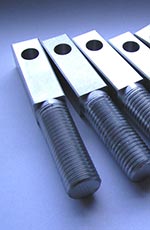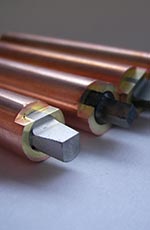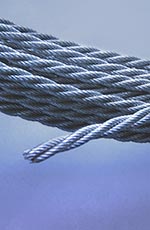Electrodes and Contacts
Tungsten-Electrodes (TIG-welding)
Usage for TIG-welding (Tungsten-Inert-Gas). Depending on the welding parameters and materials, various doped Tungsten electrodes are used.
Usage for TIG-welding (Tungsten-Inert-Gas). Depending on the welding parameters and materials, various doped Tungsten electrodes are used.
Examples for the composition and colour-coding (DIN EN ISO 6848):
| WP | (Pure Thungsten) | green |
| WCe20 | (Cerium-doped) | gray |
| WLa10 | (Lanthanum-doped) | black |
| WLa15 | (Lanthanum-doped) | gold |
| WLa20 | (Lanthanum-doped) | light blue |
| WTh10 | (Thorium-doped) | yellow |
| WTh20 | (Thorium-doped) | red |
| WTh30 | (Thorium-doped) | violet |
| WZr3 | (Zirconium-doped) | brown |
| WZr8 | (Zirconium-doped) | white |
| [WY20 | (Yttrium-doped) | blue] |
| [WMX | (Rare Earth Elements Mixture) | Cyan] |
W-Contacts (Tungsten):
Implementation in highly-stressed and rapid switching contacts, excellent arc erosion resistance. Typically available in shape of contact-rivets: Tungsten-discs with Copper or Silver-solder, brazed on Steel or Copper rivet supports. Used as breaker contacts, automotive horn and relay-contacts.
Implementation in highly-stressed and rapid switching contacts, excellent arc erosion resistance. Typically available in shape of contact-rivets: Tungsten-discs with Copper or Silver-solder, brazed on Steel or Copper rivet supports. Used as breaker contacts, automotive horn and relay-contacts.
WCu-Contacts and Electrodes (Tungsten-Copper):
Used as high current, high-voltage circuit breakers e.g. tulip-contacts. Depending on the composition respectively percentages of Tungsten and Copper, the conductivity and hardness can be varied. WCu-electrodes are also used as welding electrodes and eroding electrodes (EDM Electro-Discharge-Machining).
Used as high current, high-voltage circuit breakers e.g. tulip-contacts. Depending on the composition respectively percentages of Tungsten and Copper, the conductivity and hardness can be varied. WCu-electrodes are also used as welding electrodes and eroding electrodes (EDM Electro-Discharge-Machining).
WAg-Contacts (Tungsten-Silver, also: Silver-Tungsten - AgW):
Tungsten-Silver-Contacts maintain a very high burn-off resistance and prevents contact-welding. During the life-cycle of the switches the contact resistance increases due to a formation of Tungsten-oxide and Silver-Tungsten-Oxide.Mainly used as contacts for circuit breakers, grounding switches and others.
Tungsten-Silver-Contacts maintain a very high burn-off resistance and prevents contact-welding. During the life-cycle of the switches the contact resistance increases due to a formation of Tungsten-oxide and Silver-Tungsten-Oxide.Mainly used as contacts for circuit breakers, grounding switches and others.
Ni-W-Ni- (Ni-Mo-Ni) Lead-In-Wires:
For vacuum-feedthroughs in glass bulbs for the lighting technology Tungsten or Molybdenum-wires are melted into glass. In order to achieve a better contacting, Nickel, Nickel-alloy or Nickel-plated-steel is used for one or both ends. The different materials of the lead-in wires or pins are connected by welding.
For vacuum-feedthroughs in glass bulbs for the lighting technology Tungsten or Molybdenum-wires are melted into glass. In order to achieve a better contacting, Nickel, Nickel-alloy or Nickel-plated-steel is used for one or both ends. The different materials of the lead-in wires or pins are connected by welding.
Molybdenum / TZM-Electrodes:
Electrodes for point, roll seam and butt-welding.
Thermodes for soldering and bonding.
Contact lead-ins for lamps and current-feedthroughs
Electrodes for point, roll seam and butt-welding.
Thermodes for soldering and bonding.
Contact lead-ins for lamps and current-feedthroughs
Filaments:
Tungsten-filaments and coils are used as glow and emission wires, and stranded W-evaporator-coils are used for the vacuum-coating technology. Iridium and Rhenium filaments and ribbons are used for analysis instruments.
Tungsten-filaments and coils are used as glow and emission wires, and stranded W-evaporator-coils are used for the vacuum-coating technology. Iridium and Rhenium filaments and ribbons are used for analysis instruments.

















































